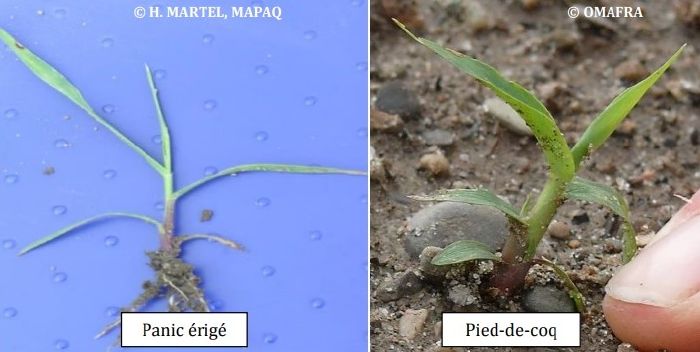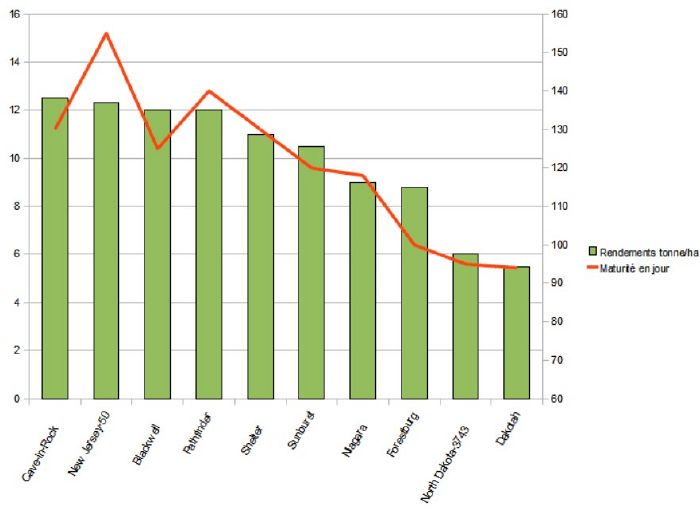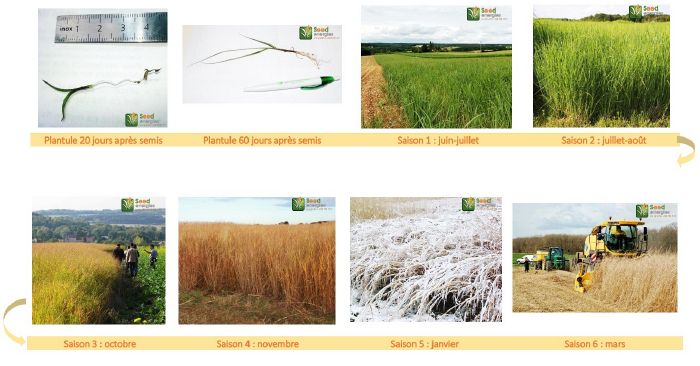Panicum virgatum

Switchgrass (Panicum virgatum L.) is a perennial herbaceous grass characterised by its high biomass production, hardiness, efficient management of soil water resources and ability to protect soils against erosion. Switchgrass is mainly used in fodder production and as a component in methanisation, but also has agronomic benefits such as boosting soil life, capturing nitrogen and improving soil porosity and density.
Physiology
Switchgrass is an herbaceous grass native to North and Central America, adapted to a warm continental climate. It belongs to the family of C4 plants (like maize and sorghum), which need more heat than most cultivated plants to develop (optimum temperature around 35°C).
Depending on the variety, it can reach a standing height of between 1 and 2.5 metres. Its root system is made up of rhizomes that can reach a depth of 3.30 m, which may explain its ability to use soil nutrients efficiently. Its extensive root cover and ability to secrete sticky exudates improve the structure of the soil in which it grows, thereby curbingsoil erosion.
Description
- Growth habit, height and roots : Tall upright stems 1 to 2.5 metres long, long scaly rhizomes.
- Leaf sheath : Round, hairless and purplish-red at the base. Switchgrass seedlings can resemble those of grassy weeds such as foxtails, crabgrass and barnyard grass. It can be distinguished by its stem, which is reddish at the base and curled up before unfolding. Annual grasses tend to have a slightly broader, flat, pale green stem (light red in the case of barnyard grass) :

- Ligule : Membranous, 1.5-3.5 mm long, hairy.
- Leaf blade : Flat, elongated, 6-12 mm wide, veined.
- Inflorescence : Open panicle, 15-55 cm long.
- Spikelets : Numerous, borne on long branches.
- Seeds : Oval, small, around 500,000 seeds/kg.
Advantages and limitations
Advantages
- High productivity potential :
- At the end of winter in favourable conditions, from the 2nd year : 10 to 20 t DM/ha and in limiting conditions : 7 to 12 t DM/ha.
- During autumn in favourable conditions : 15 to 25 t DM/ha and in limiting conditions : 10 to 20 t DM/ha[1].
- Well adapted to a wide range of soils and climates.
- Low pH requirements (5.5 to 7.5).
- Perennial crop (30 to 40 years).
- Good drought tolerance.
- Moderate fertilisation requirements.
- Requires little plant protection.
- No special equipment required for sowing and harvesting.
- Few interventions on the crop in full production.
- Presence of cover during the winter[2][3] .
Limitations
- Delicate planting (germination and emergence difficulties).
- Highly susceptible to competition from weeds in the1st and2nd years, during which weeding must be carried out.
- Depending on the variety, it may be sensitive to heavy frosts in winter and spring.
- Full production from the 2nd or3rd year after planting.
- The plot needs to be in good condition for harvesting at the end of winter.
- Low bulkdensity.
- Destruction and restoration of the plot at the end of the crop.[2][3] .
Recycling

Switchgrass is an interesting species because of its high biomass production and the structural properties and resilience of its root system. It can be grown for a number of uses :
Dry forage
Unlike most grasses, switchgrass can be harvested dry in June, making it easier to supply fodder during the summer. With similar nutrient levels to hay and easier storage, switchgrass is an alternative to conventional fodder.
Standing fodder
Switchgrass is suitable for standing fodder (harvesting the fodder in winter before it goes to seed so that the nutrients are retained in the stems), making it a new source of green fodder in winter.
Bedding
Thanks to its ability to absorb fluids, switchgrass is a good mulch for livestock farms. To see our experience on this subject, please visit this page.
Energy
- Methanisation : Because of its durability and high biomass production (in year n+2), switchgrass is a sustainable component for the methaniser. It is harvested "green" in autumn.
- Combustion : Harvested "dry" at the end of winter.
- 2nd generationbiofuel.
This crop can be declared for the CAP as an energy crop, but this perennial crop (CP) is managed as arable land (TA) under the eco-regime category.[4].
Agronomic and environmental benefits
Nitrogen
Low nitrate losses during the production phase have been observed, thanks to low inputs and good use of soil nitrogen by the crop. Observations made in the LIGNOGUIDE network show fairly low nitrogen levels in the autumn. Due to the reduced development of the crop in the first year, losses could be higher in the first year(s) following installation, but there are currently no references available to quantify this.
IFT
Switchgrass requires few plant protection inputs after establishment. The Treatment Frequency Index (TFI) and the potential for transfer of active ingredients to deep water show that pressure is particularly low, with an average TFI of 0.2 over a 15-year switchgrass growing cycle (calculations based on standard technical itineraries developed in LIGNOGUIDE[5]).
Energy production and consumption
The production of switchgrass consumes little energy, due to less fertilisation, the absence of annual tillage and the amortisation of planting and destruction operations over the entire lifespan of the crop. Fuel consumption accounts for almost 40% of energy consumption (mainly for harvesting). Energy production is much higher than this consumption.
GHG
Greenhouse gas (GHG) emissions during the biomass production stage are strongly linked to the fossil inputs used and in particular to nitrogen fertilisation. Thanks to its reduced nitrogen input requirements, switchgrass has low levels of GHG emissions per hectare (less than 1,000 kg eq. CO2 /ha[5]).
Carbon storage
Growing switchgrass couldincrease carbon storage in soils due to its high biomass production. Taking this storage into account should further improve the GHG balance.
Erosion
The soil cover provided by switchgrass and its dense, deep root network protect the soil from erosion through a mechanical effect. But it also has a physico-chemical effect through the production of stickyroot exudates that transform the soil structure and make it more resistant.
Growing the crop
- Choice of variety :
- In colder regions, we prefer "upland" varieties from the northern regions of the Great American plains, with a short maturity cycle.
- In warmer regions or in soils that warm up more quickly, we prefer "lowland" varieties from the south of the USA, with a longer maturity cycle.

- Soil preparation : Carry out soil preparation comparable to sowing grassland : fine, reconsolidated soil on the surface, with no discontinuities at depth. It is strongly recommended to carry out several false seedings before planting this crop in order to limit competition from weeds when the switchgrass emerges. This limits the use of chemical weedkillers.
- Sowing[6] : April to mid-June. Broadcast sowing should be avoided. Preferably use a disc cereal drill. If the seed remains on the surface of the soil, exposed to light, it will not germinate as it is photosensitive. Firm the soil well before and after sowing with a heavy Cambridge-type roller, to ensure perfect seed/soil contact.
- Sowing depth : As with all forage crops, maximum x 10 the size of the seed. Example : for a 1 mm thick seed, sow 10 mm deep. The seed is sown at a shallow depth of between 0.5 and 1 cm, using a conventional cereal drill followed by rolling.
- Germination temperature : Soil temperature > 14°C (Sunflower temperature > 8°C). The soil must still have sufficient moisture. The choice of sowing date must therefore be based on the location, taking these two constraints into account. In very dry conditions, irrigation can encourage rapid emergence.
- Density : 10 to 12 kg/ha (target 10 - 20 plants/m²) using a conventional drill.
- Fertilisation : No fertilisation is required in the first and second years after sowing. The crop's needs are low, and nitrogen fertilisation in the year of sowing would encourage the development of weeds. For biomass harvesting :
- N : 50 U/ha of nitrogen. An excess would cause lodging.
- P, K : 70 U/ha for yields of 10 to 15 t/ha.
Warning : Depending on the end use of the product for heating, any fertilisation will increase the ash content.
- Weed management : The only step that should not be neglected is weed control in the first two years. In the year of sowing, the plants grow from 30 to 80 cm high. It is advisable to mulch the switchgrass with a shredder in the first year to limit weed growth. It may be necessary to weed several times. Given the narrow spacing between rows, mechanical weeding is difficult to envisage.
- Irrigation : Irrigation may be considered to encourage installation in the event of a very dry late spring. Once installed, studies have shown that irrigation maximises yields.[2][5]
- Diseases and pests : Switchgrass appears to be relatively insensitive to diseases and pests. There have been a few cases of brown rust on fertilised plots, but these have had no consequences.
- Harvesting [7]: In spring (February/March) or autumn. Potential yield : 5 to 15 t DM/ha. Two harvesting techniques :
- Mowing and baling : A little more expensive but easy to store.
- Silage : Very low density (120 - 150 kg/m3) needs a large bulk storage area.
- Warning : No grazing or mowing shorter than 15 cm during the growing season.
- Storage : To keep the material healthy, a moisture content of less than 15% is recommended. Above this humidity level, the stock may heat up, leading to a deterioration in quality.
- Destruction for recultivation of the plot [8]:
- Mid-June : Harvest or crush the above-ground biomass in order to deplete the rhizome reserves, which are at their lowest at this time.
- As soon as the rhizomes start to grow again : Rotavate to destroy regrowth and break up the rhizome. Switchgrass is more sensitive to mechanical destruction than miscanthus, so there will be little regrowth afterwards. Using a total weedkiller instead of a rotavator gave equivalent results.
- End of July/August : In the event of new growth, 1 or 2 passes with a chisel to bring rhizome fragments to the surface of the soil.
- Autumn : Few new shoots are generally observed. Cereals can then be sown after light levelling using discs and a direct drill.

Cost
The following costs are calculated on the basis of standard technical itineraries, by amortizing the cost of establishment over the duration of the crop (15 years), as well as the cost of restoring the plot. Harvesting costs at the end of winter (in high-density bales) are taken into account from the2nd year onwards, as well as the loss of income (non-harvesting) in the1st and last years.
- Operating costs (seeds (€27 to €45/kg depending on the source), fertiliser, plant protection) : €1,500/ha, i.e. around €100/ha/year over 15 years.
- Specific costs (work carried out by contractors) : €143/ha[5].
Further information
- Planting Switchgrass - RMT Biomasse
- Weeding Miscanthus and Switchgrass - RMT Biomasse
- Switchgrass Establishment Can Ameliorate Soil Properties of the Abandoned Cropland in Northern China
Sources
- ↑ Switchgrass crop sheet - RMT Biomasse.
- ↑ 2.0 2.1 2.2 Biomass for energy. Final conference of the REGIX programme, 2010.
- ↑ 3.0 3.1 Switchgrass crop sheet. LIDEA programme, 2007.
- ↑ https://www.seedenergies.fr/switchgrass/declaration-pac
- ↑ 5.0 5.1 5.2 5.3 LIGNOGUIDE - guide to choosing lignocellulosic crops. CASDAR, 2013.
- ↑ Switchgrass sowing - Seedenergies.
- ↑ Harvesting Switchgrass - Seedenergies.
- ↑ Switchgrass destruction - Seedenergies.
- ↑ https://www.fdc80.com/medias/files/7-fiche-technique-switchgrass.pdf